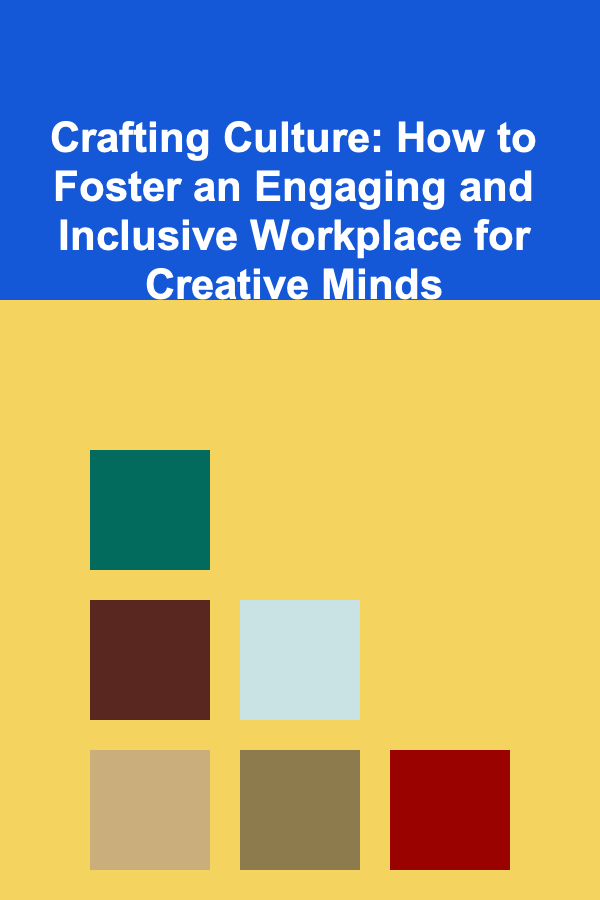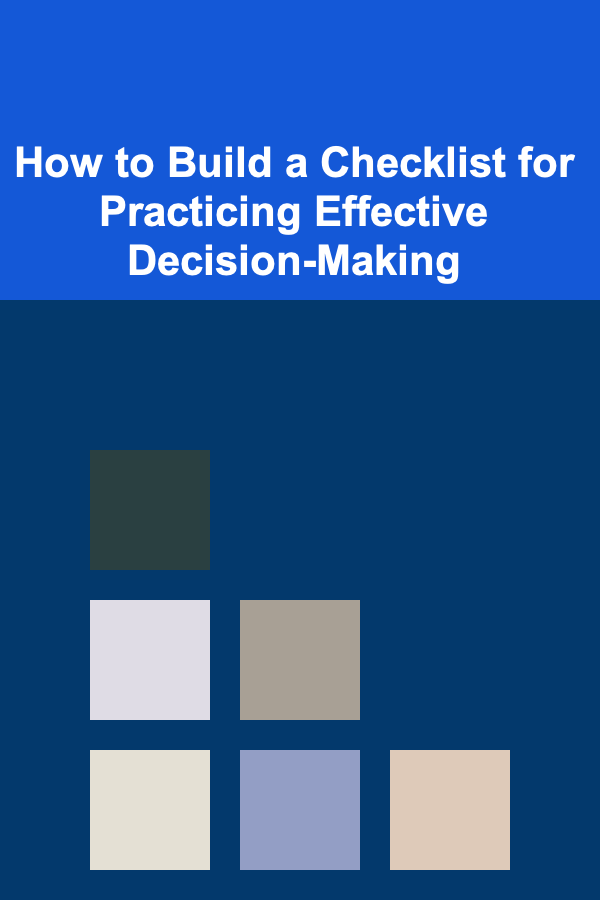
Crafting Culture: How to Foster an Engaging and Inclusive Workplace for Creative Minds
ebook include PDF & Audio bundle (Micro Guide)
$12.99$7.99
Limited Time Offer! Order within the next:

In today's fast-paced, ever-evolving work environment, creative professionals need a space that not only sparks innovation but also promotes collaboration, inclusivity, and engagement. The way a workplace culture is shaped can directly impact the creativity and productivity of its people. As organizations strive to remain competitive and relevant, fostering a culture that supports creativity and inclusivity becomes an essential strategy for success.
This guide explores how to build an engaging and inclusive workplace for creative minds, with actionable steps to ensure that creativity flows, diverse perspectives are celebrated, and individuals feel empowered to contribute their best ideas.
Understanding the Importance of Culture for Creative Minds
Culture in the workplace goes beyond just perks and benefits; it is the underlying force that shapes behavior, influences morale, and fosters collaboration. For creative professionals, a thriving culture can enhance problem-solving abilities, encourage new ways of thinking, and improve overall job satisfaction.
Creative minds, whether they are designers, marketers, engineers, or content creators, need an environment that challenges them intellectually, offers them autonomy, and provides support to bring ideas to life. Without a positive, inclusive, and empowering culture, creative individuals may feel stifled, disconnected, or even undervalued.
Key Components of a Creative Workplace Culture:
- Psychological Safety: A culture where individuals feel safe to express their ideas, even if they are unconventional or incomplete. It's crucial for innovation to flourish.
- Collaboration Over Competition: Creative minds thrive when they can collaborate with others. Fostering an environment of teamwork can lead to richer ideas and solutions.
- Respect for Diverse Perspectives: Inclusivity doesn't just mean diversity in hiring; it's about respecting and valuing different viewpoints and lived experiences. These diverse perspectives can lead to more innovative outcomes.
- Autonomy and Empowerment: Giving creative individuals the freedom to explore ideas and make decisions boosts their ownership of their work and encourages a higher level of engagement.
Building an Inclusive Culture: Where Diversity Drives Creativity
Inclusivity is about more than just having a diverse workforce. It's about creating an environment where everyone, regardless of their background, feels like they belong and their unique contributions are valued. A truly inclusive workplace actively embraces and celebrates differences---be it cultural, gender, age, or experiential.
Actionable Steps for Building Inclusivity:
- Leverage Diverse Hiring Practices: Begin by diversifying your recruitment strategy. Hire individuals from a wide range of backgrounds and life experiences. Diverse teams bring fresh perspectives that are essential for innovation.
- Promote Equal Opportunities: Ensure that all employees, regardless of their background, have equal access to opportunities for career advancement. This includes mentorship programs, training, and leadership development initiatives.
- Listen to Diverse Voices: Regularly engage with employees to understand their experiences. This could be through anonymous surveys, one-on-one meetings, or focus groups. Ensure that everyone feels heard and that their feedback influences company policies and decisions.
- Celebrate Different Cultures: Hold events, discussions, or workshops that highlight the importance of cultural diversity. This could include celebrating international holidays, hosting speaker events, or simply sharing stories of diverse cultural experiences.
- Create Inclusive Leadership: Ensure that leadership teams reflect the diversity of the broader workforce. When employees see themselves represented in leadership roles, it reinforces the idea that they can succeed in the organization, regardless of their identity.
Fostering Engagement: Encouraging Participation and Ownership
An engaged workplace is one where employees feel connected to their work and the mission of the organization. For creative professionals, engagement goes hand-in-hand with their ability to innovate and contribute meaningful work.
Actionable Steps to Foster Engagement:
- Align Individual Purpose with Company Mission: Help creative minds understand how their work aligns with the broader organizational goals. This alignment fosters a sense of purpose and connection to the company's mission.
- Provide Autonomy and Flexibility: Creativity thrives when individuals are given the space to explore and experiment. Allow flexible working hours, remote work options, or flexible project timelines that give creative individuals the room to work in their own way.
- Encourage Ownership and Accountability: Empower employees by allowing them to take full ownership of projects. Giving them the responsibility for decision-making within their roles boosts engagement and instills a sense of pride in their work.
- Offer Constructive Feedback: Ensure that feedback is not only constructive but also motivating. Recognize accomplishments regularly and offer feedback that encourages growth rather than discouragement.
- Organize Cross-Functional Collaboration: Promote interaction between different teams within the organization. Creative ideas often arise when individuals from diverse disciplines come together and share insights. Whether it's through brainstorming sessions, workshops, or collaborative projects, cross-functional collaboration can spark new ideas and push boundaries.
Creating a Safe Space for Creativity to Flourish
A creative workplace must allow for experimentation without the fear of failure. Creativity often requires risk-taking, and if employees feel that their ideas might be judged or rejected prematurely, they may hesitate to innovate. Thus, creating a psychologically safe space where individuals can share, test, and refine their ideas is essential.
Actionable Steps to Create a Safe Creative Space:
- Encourage Experimentation: Promote a mindset where failure is seen as a stepping stone toward innovation rather than something to be avoided. Encourage your team to take risks and try new approaches, knowing that mistakes are a natural part of the creative process.
- Normalize Constructive Criticism: Establish a feedback culture where critiques are seen as helpful rather than punitive. Ensure that feedback is delivered in a way that is actionable and positive, focused on helping individuals grow rather than pointing out flaws.
- Create Opportunities for Idea Sharing: Organize regular brainstorming sessions, idea-sharing workshops, or innovation days where creative minds can freely present their concepts. Allow employees to pitch their ideas without fear of rejection or dismissal.
- Support Work-Life Balance: A burnt-out creative mind cannot produce great work. Support your team in maintaining a healthy work-life balance, as well-rested and mentally rejuvenated individuals are more likely to come up with fresh ideas and approaches.
Leadership's Role in Cultivating a Creative and Inclusive Culture
The leadership team plays a pivotal role in shaping workplace culture. Their actions and decisions set the tone for the organization and determine whether the culture fosters inclusivity and creativity. It's not enough for leaders to simply talk about inclusivity and creativity; they must model these values through their behavior and interactions.
Actionable Leadership Strategies:
- Lead by Example: Leaders should actively demonstrate the behavior they expect from others. Whether it's actively promoting diversity, encouraging open communication, or showing a commitment to personal growth, leadership sets the stage for organizational culture.
- Invest in Creative Development: Leaders should prioritize the development of their team's creative skills. This could be through offering training, attending creative conferences, or even providing access to tools and resources that foster creative growth.
- Promote Mental Health and Wellbeing: Creativity can be mentally demanding, and supporting the mental health of employees is crucial. Implement wellness programs, mental health days, and resources that allow employees to prioritize their emotional well-being.
- Encourage Open Communication: Create channels where employees feel comfortable voicing concerns, offering suggestions, or sharing feedback. An open, transparent communication system fosters trust and strengthens the inclusive nature of the workplace.
- Celebrate and Recognize Contributions: Regularly celebrate the contributions of creative minds within the organization. Recognize both individual and team accomplishments, showcasing their work to inspire others and foster a sense of pride.
Creating the Right Environment: Physical and Digital Spaces for Creativity
The environment in which employees work can have a significant impact on their creativity. From office layouts to digital tools, the right environment can help individuals feel more comfortable, engaged, and ready to collaborate.
Actionable Steps to Optimize the Creative Environment:
- Design Inspiring Workspaces: Create flexible, open spaces that encourage collaboration but also provide quiet areas for focused work. A good balance between social spaces and private areas helps employees move between different modes of work.
- Provide Access to the Right Tools: Invest in the tools that foster creativity, whether it's state-of-the-art design software, virtual collaboration tools, or physical materials. Ensure that employees have the resources they need to perform at their best.
- Encourage Digital Collaboration: In today's hybrid work world, it's essential to provide digital tools that promote collaboration. Platforms like Slack, Microsoft Teams, and creative collaboration tools such as Miro or Figma help teams work together seamlessly, even when not in the same room.
- Incorporate Flexibility in Work Environments: Whether it's providing employees with the option to work from home or offering flexible workspaces within the office, creating a culture of flexibility can lead to more productive and creative outcomes.
Conclusion
Building an engaging and inclusive workplace for creative minds is not an overnight task. It requires thoughtful planning, consistent effort, and a deep commitment to fostering an environment where creativity, diversity, and inclusion can thrive. By prioritizing psychological safety, collaboration, respect for diversity, and creating a space where employees feel empowered to contribute their best work, organizations can unlock the full potential of their creative talent.
In the end, a workplace culture that embraces inclusivity and creativity not only benefits the individuals within it but also drives the success of the organization. By cultivating such a culture, companies can position themselves as leaders in innovation, attracting the brightest creative minds and fostering an environment where great ideas can flourish.

Developing a Digital Music Player: An Actionable Guide
Read More
How to Build a Checklist for Practicing Effective Decision-Making
Read More
How to Create a Soundproof Music Room in Your Home
Read More
How to Keep Track of Appliances and Electronics in Your Home
Read More
How to Set Up DIY Indoor Games for Family Fun
Read More
How to Soundproof Your Home from External Traffic Noise
Read MoreOther Products

Developing a Digital Music Player: An Actionable Guide
Read More
How to Build a Checklist for Practicing Effective Decision-Making
Read More
How to Create a Soundproof Music Room in Your Home
Read More
How to Keep Track of Appliances and Electronics in Your Home
Read More
How to Set Up DIY Indoor Games for Family Fun
Read More